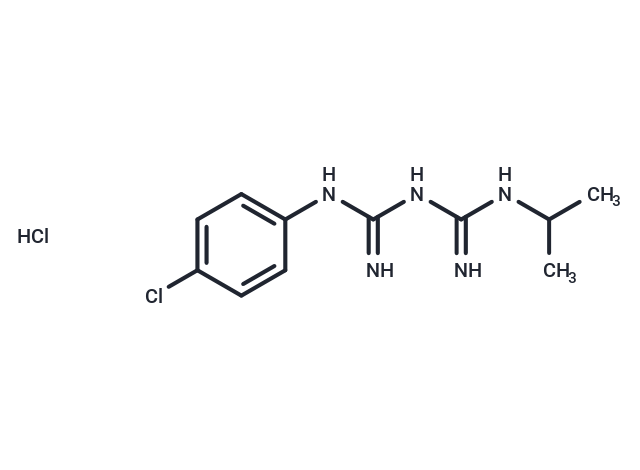Shopping Cart
- Remove All
 Your shopping cart is currently empty
Your shopping cart is currently empty


| Pack Size | Price | Availability | Quantity |
|---|---|---|---|
| 5 mg | $50 | In Stock | |
| 10 mg | $60 | In Stock | |
| 25 mg | $102 | In Stock | |
| 50 mg | $190 | In Stock | |
| 100 mg | $340 | In Stock | |
| 200 mg | $545 | In Stock | |
| 500 mg | $878 | In Stock | |
| 1 mL x 10 mM (in DMSO) | $64 | In Stock |
| Description | Proguanil hydrochloride (Chloroquanil) is a biguanide compound which metabolizes in the body to form cycloguanil, an anti-malaria agent.Upon hydrolysis, Proguanil hydrochloride is converted to its active cyclic triazine metabolite, cycloguanil, by a cytochrome P450 dependent reaction. Cycloguanil selectively inhibits the bifunctional dihydrofolate reductase-thymidylate synthase of plasmodium parasite, thereby disrupting deoxythymidylate synthesis and ultimately blocking DNA and protein synthesis in the parasite. |
| In vitro | proguanil appeared to be a substrate of OCT1 and OCT2 with affinities of 8.1 and 9.0 μM, respectively |
| Cell Research | Sertoli cells obtained from sixteen to eighteen day-old-rats are cultured and treated with 0.3 μM to 10 μM of proguanil for 5 days after which Sertoli cell viability and nuclei integrity are determined. Also, the genetic expressions of transferrin and Glial cell line-derived neurotrophic factor are assessed. They are for reference only. |
| Animal Research | Proguanil is prepared in distilled water.Rats: Groups of ten to twelve-week-old rats are administered proguanil (2.9 mg/kg body weight) daily for 5 days and 6 weeks respectively. Thereafter, body and reproductive organ weights are taken, sperm parameters are analyzed, while the histology of the testis and epididymis are carried out. Also, serum levels of testosterone, luteinizing hormone and follicle stimulating hormone are determined. They are for reference only. |
| Alias | Paludrine hydrochloride, Chlorguanide hydrochloride, Chloroquanil |
| Molecular Weight | 290.19 |
| Formula | C11H17Cl2N5 |
| Cas No. | 637-32-1 |
| Storage | Powder: -20°C for 3 years | In solvent: -80°C for 1 year | Shipping with blue ice. | |||||||||||||||||||||||||||||||||||
| Solubility Information | DMSO: 55 mg/mL (189.53 mM) | |||||||||||||||||||||||||||||||||||
Solution Preparation Table | ||||||||||||||||||||||||||||||||||||
DMSO
| ||||||||||||||||||||||||||||||||||||

Copyright © 2015-2024 TargetMol Chemicals Inc. All Rights Reserved.